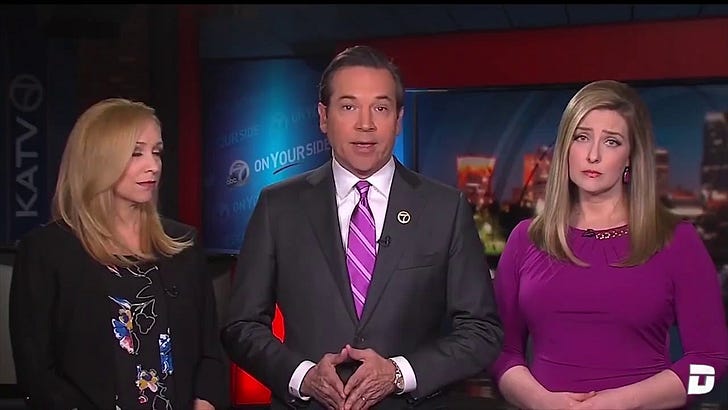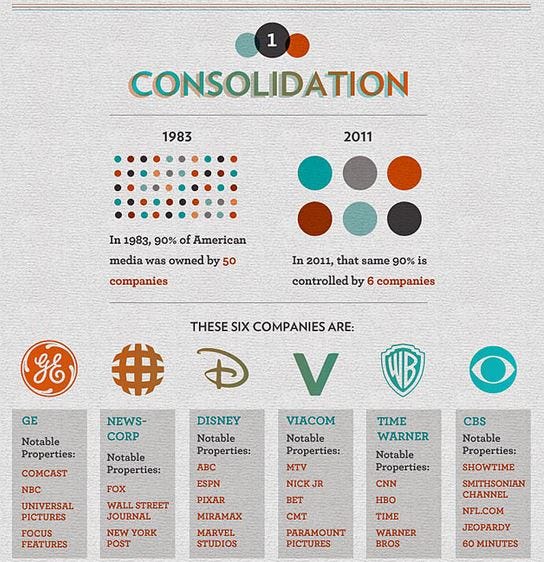The first time I ever remember being truly terrified was halloween when I was around 5 years old. I climbed the stairs to a dimly lit porch where a clown slumped in the swing. Unaware of the nature of humans and the concept of fear I moved forward as the clown jumped at me. I flew down the stairs and sprinted across the street. That day I learned that fear can freeze time, rendering you paralyzed. On the other hand it can make you hyper focused on the reality of what is happening.
As the media continues to cover the current events in Los Angeles, I hope to add clarity to my community and empower readers and viewers to dig deeper. To do this I will be diving into the four sections below:
Who’s telling the story?
Who benefits?
Who is missing?
What behaviors or values are being normalized?
“We accept the reality of the world with which we're presented. It's as simple as that.”
“The Truman Show.”
Who’s Telling the Story?
On June 1, 1980 CNN Launched what would be the first 24 hour news cycle. Prior to this invention news networks operated at a local level, primarily as a source of information for the community. If you are interested in more of the history I am including a slide deck1 that I share with my Broadcast Journalism students, but for now we will start at modern day consolidation.
In 1983, a fews years after the invention of the 24 hour news cycle there were roughly 50 companies operating in the media space. As of today there are around 6 companies that control American media, making our perception of choice an illusion. This consolidation has been applied to food, automotive, and entertainment, just to name a few. This perceived illusion divides us as we feel like there are different narratives, but they are one in the same.
This consolidation was made possible by the Reagan administrations cancelling of the Fairness Doctrine of 1949. In simple terms, the doctrine was used to regulate media outlets and make sure the included conflicting opinions on their airwaves. With the rise of cable television surpassing over the air news, Reagans administration found it an unnecessary regulation. The idea at the time was anyone could find a news network with differing perspectives because of the variety of choice. An idea that put the impetus on the consumer to fact check and seek out conflicting ideas. The FCC (Federal Communications Commission) made this official by repealing the doctrine in 1987 forcing fact checking and cross references to the viewer instead of the media outlet.
Who Benefits?
Prior to the rise of cable news viewers were able to acquire information over the airwaves. A small antenna would connect you to your community, allowing you to see the same information at the same time. Media outlets were beholden to advertisers revenue and viewer retention, meaning that loss of trust would lead to less viewer and less advertisers. This model is not perfect, but it puts responsibility on the media outlet to present truth, as it is at that moment, while also leaving room for more discourse and understanding.
When cable news arrived the monetization model was shifted to the viewer paying for information. In this change of financial model cable news providers shifted to around the clock coverage of events, sometimes with little to no information about the event as its unfolding in real time. This shift changed viewers to consumers who are paying for specific coverages from their favorite news sources. This consolidation put viewers into eco-chambers of information. This combined with the cancellation of the Fairness Doctrine allowed companies to start acquiring networks with a simple goal of communicating with more people at the same time.
“When you control opinion, as corporate America controls opinion in the United States by owning the media, you can make the masses believe almost anything you want, and guide them as you please”
-Gore Vidal-
Who Benefits?
In 1971 Julian Sinclair started the Sinclair Group, a media company creating one of the first UHF frequencies on the air. You don’t need to know everything about VHF vs. UHF, but basically this was a huge step forward in broadcasting over the airwaves. If you are interested in the history of Sinclair, you can click HERE.
Sinclair would be fairly small until the early 90’s where they began acquiring local news stations around the country. While sources vary on the number of stations they currently operate, the most referenced is from 2018 where they owned over 186 stations reaching over 70% of Americans. While these numbers are most likely higher today, we will work with the numbers presented from the Free Press and the current list of stations compiled HERE
Sinclair Script
Who is missing?
Growing up I was under the impression that my local news station was locally owned and operated as it was a service to the community. How would a company in Maryland know what small towns in Iowa, Michigan or Kansas needed. Why would the script be the same despite a different group of people being included in each market. Things were missing. Local peoples voices were missing. A move that has become exacerbated as we divide people into silos of information. So why are local stations not locally owned, and how do we inform people when the information stream is operated by roughly 6 companies. The better question may be what is it about the news that triggers this emotional response?
What seems to be missing is a local perspective, because the company is not locally owned. This has become very apparent to consumers over the past five years as our divisiveness is being triggered from headlines and news content aimed to divide viewers. This became the business model when we shifted from viewers of the news to consumers. Consumers pay for a product, and when that product is not what you want to hear then you leave. If you leave, the corporation loses money or they adjust the information to align with their customer bases opinions. This is the current “reality” of media.
What behaviors are being normalized?
If you have been reading my substack for any amount of time you may have seen me quote “Amusing Ourselves to Death” by Neil Postman. In this book, Postman presents us with a thought experience around mediums as metaphors. The visual medium is based on manipulation and construction of reality, not actual reality. If the medium is the metaphor then news is completely fabricated and requires the viewers perspective to add context.
When teaching broadcast journalism I usually start with an experiment to show how easy this is to manipulate a group. I provide different groups of students with different angles of the same photo series around a real event, but I don’t tell them that they all have different images. Based on only the information they are provided they must come up with a headline that represents the “facts” that are presented to them at this moment. They then share out their news report and I watch the students faces contort in confusion as they don’t understand. I then present the rest of the information to them so they can see the role of the media in conveying information. At any given time we are always lacking context of the images or situation, and knowing this as a viewer helps to rationalize the experience. By Postman’s theory, the medium is built on manufacturing points of view, therefore the metaphor is manipulation. Just like filmmaking, the emotions are part of the visual experience. So what values are/should media normalizing?
When I was in college we were taught “If It Bleeds it Leads”, basically saying that violence and anger are great for viewer retention. This type of psychological effect is seen across all media and shows that us humans are inherently flawed. This is why we see so much violence in media despite FBI data supporting the contrary (Click HERE to see more data)
So is it really that bad or should we become better viewers and question what we are seeing.
What’s Next?
Currently, as of writing this, we are in the middle of orchestrated ICE raids in Los Angeles County. These raids have been accompanied by anti-ice protests trying to protect their community members. So in an effort to context, I have added links to articles that were used to contextualize this article2
So if it takes this much research on my own to contextualize something that is happening 10 miles away, then how will someone across the globe know what is really happening? You probably won’t especially if 70% of the country is getting information about Downtown Los Angeles from Maryland.
As I tell my students, you have a responsibility when you share information with the world. It is your perspective and your truth, but your audience may consume it blindly allowing you to wield power in ways that we have yet to see. If you are getting a negative emotional response from your media, know that this is not an accident, its part of the medium. It’s something I have been unteaching myself for quite sometime.
In the days and weeks ahead we will learn a lot about the path forward. It is my hope that this empowers you to learn and hold two ideas in your mind at the same time. I hope that you share your perspective and stories with the world, including the positive ones. While I was taught that if it bleeds it leads, I now know that this may be a good business model, but it actually creates a perception of reality that isn’t true. It’s a way to keep us divided while corporations buy up more reach.
I will now leave you with something I wrote for my journalism class as they went out into the world.
“Be confident enough to know when you are right, and humble enough to admit when you are wrong.”
-Jerry J White III-
“LA braces for fourth day of protests as Trump deploys 2,000 national guard”
The Guardian
https://www.theguardian.com/us-news/2025/jun/09/los-angeles-protests“What to know after weekend of L.A. protests over immigration raids”
The Washington Post
https://www.washingtonpost.com/nation/2025/06/09/la-protests-immigration-ice-raids-national-guard-explained/“What are the LA protests about? Five things to know”
The Times (UK)
https://www.thetimes.co.uk/article/what-la-protests-about-fact-check-vnxxqzdkm“ICE raids at LA clothing warehouses spark major protests in Westlake and Paramount”
Los Angeles Times
[Link unavailable — recommended keyword search: “ICE raids Paramount LA Times June 2025”]“Nearly 900,000 undocumented immigrants live in LA County, USC study finds”
Los Angeles Daily News
https://www.dailynews.com/2023/03/23/nearly-900000-undocumented-immigrants-live-in-la-county-usc-study-finds/“California AG Bonta, Gov. Newsom sue over unconstitutional National Guard deployment”
CalMatters
https://calmatters.org/justice/2025/06/california-national-guard-lawsuit/“LAPD says protests mostly peaceful, few reports of looting or property damage”
Spectrum News 1 SoCal
https://spectrumnews1.com/ca/la-west/public-safety/2025/06/08/lapd-la-protests-update“LA’s immigrant population: How many, where from, and why it matters”
Pew Research Center
https://www.pewresearch.org/hispanic/2024/12/10/los-angeles-immigrant-demographics/“ICE confirms 118 detained in Westlake/Paramount raids, 44 face removal orders”
NBC Los Angeles
https://www.nbclosangeles.com/news/local/ice-raids-westlake-paramount-june-2025/“Media panic vs. protest truth: what really happened in Los Angeles”
The Intercept
[Click: “The Intercept LA ICE protests June 2025”]




